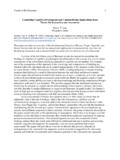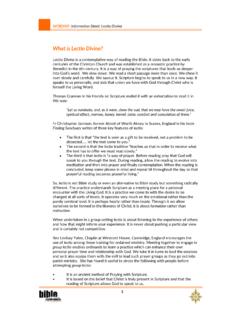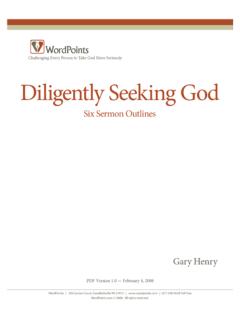Transcription of An Introduction to Spiritual Development
1 Spiritual Development 1 An Introduction to Spiritual Development William G. Huitt Jennifer L. Robbins Citation: Huitt, W., & Robbins, J. (2003). An Introduction to Spiritual Development . Paper presented at the 11th Annual Conference: Applied Psychology in Education, Mental Health, and Business, Valdosta, GA, October 3. Retrieved [date], from This paper provides an overview of Spiritual Development in children and youth and describes the role of schooling in this domain. The first section explains important terms and establishes the importance of spirituality in as a component of life success. The second section discusses some important issues regarding the Development of spirituality . A review of how to stimulate and assess Spiritual Development is also included.
2 spirituality is a difficult concept to define. While it has been explored throughout human history as one of the three fundamental aspects of human beings ( , body, mind, spirit) (Huitt, 2003), there is widespread disagreement as to its origin, functioning, or even importance (Huitt, 2000). However, in a broad perspective, spirituality deals fundamentally with how we approach the unknowns of life, how we define and relate to the sacred. spirituality is considered by many psychologists to be an inherent property of the human being (Helminiak, 1996; Newberg, D Aquili, & Rause, 2001). From this viewpoint, human spirituality is an attempt to understand and connect to the unknowns of the universe or search for meaningfulness in one s life (Adler, 1932/1980; Frankl, 1959).
3 Likewise, Weaver and Cotrell (1992) propose that spirituality refers to matters of ultimate concern that call for releasing the passions of the soul to search for goals with personal meaning ( ). Other definitions include a relationship with the sacred (Beck & Walters, 1977), an individual's experience of and relationship with a fundamental, nonmaterial aspect of the universe (Tolan, 2002). Others view soul or spirit as a description of the vital principle or animating force believed to be within living beings (Zinn, 1997, p. 2) or the very source of energy that lives within each person (Chee, 2002, p. 11). Danesh (1994) suggests that when individuals study their human spirituality it provides an opportunity to connect to a larger source of energy and power, thereby impacting our ideas of who we are.
4 It is this exploration of the meaningfulness of our lives and our relationships to ourselves, to others, to nature, or to a higher power that is considered the essence of spirituality (Hamilton & Jackson,1998; Hay & Nye, 1998). One can engage in a search in any or all of these areas simultaneously (Collins, 1998). This may or may not involve a relationship with God, Goddess, Creator, Great Spirit, Universal Mind, etc. However, it does involve a quest for a relationship with, or understanding of, the essential or non-material as compared to the concrete or material. There are essentially three broad categories of belief regarding humankind s spirituality : naturalism, pantheism, and theism (Copan, 2001). Naturalists believe spirituality and definitions of what is sacred exist as a natural operation of the human mind and that our spirituality ceases to exist along with our physical body (Maslow, 1983).
5 Pantheists believe that God exists in everything and that the entire universe is either God or an expression of His nature (Levine, 1997). Theists believe that humankind s spirituality results from a non-material soul, created by God, and destined to continue to exist after the material body ceases to function (Collins, 1998). Spiritual Development 2 Solomon (2002) suggests that a belief in a Creator or Great Spirit is not necessary as atheists or skeptics can express their spirituality through a philosophical inquiry that is demonstrated in a thoughtful love for life. This discussion of the essence of human spirituality links the topic to religion. However, there is an important distinction. Whereas spirituality is a consideration of meaning or ultimate purpose, religion refers to the organized, institutionalized set of beliefs, teachings, and practices that are established to connect groups of individuals to a particular expression of spirituality (Tolan, 2002).
6 One can be Spiritual without being religious ( , a seeker of a relationship with the Creator without belonging to a particular practice of that relationship). Alternatively, one can be religious without being Spiritual ( , practicing a particular set of rituals or attending a specific worship service without establishing a relationship with the sacred, non-material aspects of the universe). This distinction is an important part of the discussion of Spiritual Development in the context of schooling. Coles (1990) provides extensive detail on the difference between children s interpretation of the signs, symbols, and rituals of their religious upbringing and their quest to provide meaning to their lives. He suggests, however, that these are not independent, as a child s Spiritual journey is done within the context of an individual s religious (or non-religious) training.
7 Meeting the directive of the United States Constitution to maintain neutrality between secular and religious views (Segars & Jelen, 1998) does not mean that we must omit all discussions of human spirituality from our public institutions. That is hardly neutral. It does mean, however, that we must be careful to allow a full discussion of Spiritual Development that includes the views of both those who believe in a Supreme Creator, God, or Great Spirit and those who do not. It also means that we must treat the wisdom found in the various religious scriptures with equality, rather than in a parochial, biased manner. Wilson (2000) suggestes this is possible by focusing on those Spiritual and moral goals that are needed for lasting human happiness using findings from both science and religious scripture.
8 While this discussion of connecting Spiritual Development to a belief in a God or Universal Spirit may be an important issue to the majority of scientists who identify themselves as unbelievers (Larson & Witham, 1998), it is certainly not an issue for the majority of the American public. Gallup (1993) reports that 94% of adult Americans believe in God or a universal spirit, although less than 50% attend religious services on a regular basis (Gallup International, 1999). Similar results are found throughout the industrialized world (Huddleston, 1993). The number of people who identify themselves as believers but express no specific religious identification almost doubled in the in the 1990s (from 8% to 14%) (Gallup International, 1999).
9 This now makes the unchurched million American adults the third largest group of believers in America, after Roman Catholicism ( million) and Baptists ( million). It is interesting to note that measures of increased interest in spirituality have increased at the same rate as leaving organized religion (Marler & Hadaway, 2002). This discrepancy between beliefs and practice may be one reason that people seem to be seeking spirituality (Taylor, 1994). Hout and Fischer (2002) believe this growth of unchurched believers in the is a result of dissatisfaction with the manner in which Christian views have been expressed in the public discourse. What is clear is that whether the topic of spirituality and its various interpretations is addressed from the perspective of science, religious observers, or unaffiliated believers, it is considered important by the American public.
10 In addition, spirituality and related processes of Spiritual Development 3 Spiritual Development such as a profession of faith, prayer, or regular attendance at religious services have been related to a wide-range of important outcomes such as: lower blood pressure (Koenig, 1999), improved physical health (Koenig, McCullough, Larson, 2001; Levin, 2001), healthier lifestyles and less risky behavior (Koenig, 1999), improved coping ability (Pargament, 1997), less depression (Koenig, 1999), faster healing (Dossey, 2002; Koenig, 2002), lower levels of bereavement after the death of a loved one (Walsh, King, Jones, Tookman & Blizard, 2002), a decrease in fear of death (Ardelt, 2000), and higher school achievement (Ginsburg & Hanson, 1986).







